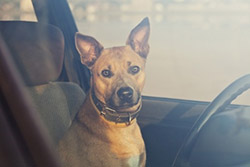Last updated: September 6th, 2020
Aren’t summer days great? It’s so nice to be able to enjoy the hot and sunny weather, but while we enjoy basking in the warmth of the sun, it’s important to prevent our pets from becoming overheated. Cats and dogs can’t cool themselves in the same way that humans can, and a pet that becomes overheated can suffer from dehydration, and in severe cases, die.
Dogs mostly cool themselves by panting, and cats sweat through their paws although they may start panting if it gets too hot for them. Cats may also groom themselves more frequently, as by licking themselves and leaving saliva on their fur, when this evaporates it reduces their temperature.
Some pets are more vulnerable to dehydration than others, such as those who are overweight, have long or thick coats, are suffering from heart or respiratory diseases and breeds with short or flat noses.
However, if you follow the advice in this article, you and your pet can enjoy the summer without suffering from the heat.
Note: For advice on what to do if you see a dog locked in a car, you can jump straight down to this section: What to do if You See a Dog in a Hot Car
1. Provide Water
 It is important to provide your pet with a constant source of fresh, cool water all through the year, but this is even more essential when the weather is hot. Becoming dehydrated is a big risk to pets during the heat of the sumer, so it’s crucial to provide them with access to a drinking source at all times.
It is important to provide your pet with a constant source of fresh, cool water all through the year, but this is even more essential when the weather is hot. Becoming dehydrated is a big risk to pets during the heat of the sumer, so it’s crucial to provide them with access to a drinking source at all times.
Provide at least one bowl of water, and make sure it is always filled. If your pet spends time outdoors, then make sure they always have a source of fresh water both outside and indoors.
You could also consider a water fountain to try and encourage your pet (cats especially) to drink. You can find out more, and see some examples by reading our review of 15 of the best water fountains.
You could also try adding ice cubes to a second water bowl. Not all animals will appreciate this, as they might find it too cold, so make sure there is always another source of non-chilled water nearby just in case.
Note: Contrary to various hoax emails circulating on the internet, drinking cold water mixed with ice cubes does not cause bloat in dogs – however it can be caused by a dog consuming too much water too quickly. So if your dog is hot and thirsty, don’t let them drink too much water at once.
2. Provide Shade
If your pet has access outside, make sure there are some shaded areas for your pet to take cover under. Cats and dogs may enjoy a bit of sunbathing, but they need a cool, shady spot to relax. Too much exposure to the sun can cause heat exhaustion or even sunburn.
If there are no natural shady spots (under a tree for example), then you can create your own – ideally in a spot that gets a gentle breeze.
If your pet lives outside (for example, a rabbit in a hutch) make sure that the hutch is in the shade all day – this may mean it is necessary to move it as the sun changes direction.
3. Avoid the Heat
Try to keep your pet inside during the hottest part of the day (usually between 10am and 3pm), and keep the blinds or curtains closed to keep your house cool. You could also consider an electric fan, or even a portable air-conditioner unit which will help reduce temperatures in a hot room, especially if you need to keep windows closed to prevent your pet from escaping.
Avoid taking your dog for a walk during this time – try to go in the early morning or late evening, when temperatures are cooler.
Their paw pads could also be burned walking across very hot surfaces, so this is another reason to keep them indoors when the temperature is particularly high outside. Protective doggie boots are a good way to protect your dog’s paws from the heat if they are likely to walk on hot surfaces like pavements or sand.
Note: If you have a cat, take extra care when closing the doors on outdoor buildings such as sheds and greenhouses to make sure they are not inside. The building could become very hot during the day, and this could prove fatal if your cat was accidentally locked inside.
4. Let Your Pet Choose a Cool Spot
Cats especially will naturally gravitate to a tiled floor, or ceramic sink or bath as these materials stay cool even when it’s hot outside. If your cat decides to curl up in the sink, don’t tell them off or try and move them – leave them be to cool down using their own initiative.
5. Paddling Pools
 Does your dog love water? If the answer to that question is yes, then a large tub or plastic pool in your garden might be a great idea! Place the pool somewhere that is in the shade, and change the water frequently. Something like this Doggy Pool would be perfect!
Does your dog love water? If the answer to that question is yes, then a large tub or plastic pool in your garden might be a great idea! Place the pool somewhere that is in the shade, and change the water frequently. Something like this Doggy Pool would be perfect!
Many dogs will enjoy playing and relaxing in the cool water – especially on a hot day, but make sure you supervise your pet at all times.
6. Cool Them Down
If your pet is hot and bothered, you can dampen a cloth or towel and gently stroke your pet from the top of its head and down the back. You can also concentrate on the areas where they lose heat the most such as their bellies, the underside of their paws, under their armpits and the outside of their ears. Another option is to use a water misting spray to cool them down.
You could also cool down a damp towel by placing it in the freezer until it is cold enough (not frozen though) and then lay it on a smooth kitchen or bathroom floor. Don’t force your pet to use it, but just introduce them to it and let them make up their own mind.
Alternatively, you could place a freezer ice pack, or hot water bottle filled with cold water underneath a towel in their usual sleeping place for a similarly cooling effect.
Dog Cooling Coats are also available; these are activated by water, and use evaporation to help cool your dog down.
7. Groom Your Pet
Regular brushing of your pet’s fur will get rid of loose hair and ensures it does not get matted, which can trap heat. If you have a long-haired breed, then it’s worth considering getting their fur clipped for the summer to help reduce the risk of them overheating.
8. Keep Them Calm
If your pet is excitable, and runs around too much on a really hot day, they could become overheated. Don’t encourage them to play when the temperature is high, and provide a relaxed environment that is both cool and dark to help keep them calm down.
9. Don’t Leave Your Pet in a Car
 Never, ever leave your pet in a car, even for a few minutes. Even leaving a window open, fitting a windscreen sun shade or leaving a bowl of water isn’t enough to keep the car and your pet sufficiently cool, and even on a mild day, it can soon be dangerously hot inside the car within a matter of minutes.
Never, ever leave your pet in a car, even for a few minutes. Even leaving a window open, fitting a windscreen sun shade or leaving a bowl of water isn’t enough to keep the car and your pet sufficiently cool, and even on a mild day, it can soon be dangerously hot inside the car within a matter of minutes.
Dogs cool themselves down by panting, so if the air around them is too hot and stuffy they are unable to regulate their body temperature, and they will over-heat. Inside the small and enclosed space of a car they will simply not be able to get enough fresh air to keep themselves cool.
Once their body temperature goes over 41°C, it will not take long for a dog to suffer irreparable vital organ damage, brain damage and eventually an agonising death.
According to the RSPCA, when it is 22°C outside, the temperature inside a car can reach a dangerously high 47°C within an hour. On a hot, sunny day, leaving a dog in a car for just 10 minutes can be fatal.
If your dog suffers or even dies as a result of being left in a hot car, you can be prosecuted. So as well as losing a beloved pet, you may also end up with a criminal record and being banned from keeping animals in the future.
What to Do if You See a Dog in a Hot Car
If you see a dog that has been shut in a locked car, then the advice from the RSPCA is:
If the dog is not showing signs of distress:
- Try to work out how long they have been in the vehicle (is there a Pay and Display parking ticket visible?).
- Get someone to stay with the vehicle to keep an eye on the dog’s condition in case they begin to show signs of distress.
- Try to contact the owner – for example if in a supermarket car park, ask the staff to make an announcement.
- Make a note of the vehicle’s registration number, and be prepared to contact the police if the dog’s condition gets worse.
If the dog is in distress:
- Contact the police by dialling 999.
- Take photos and/or video of the dog as evidence.
- Get the name and contact details of any witnesses.
Important Note: Only the police are legally allowed to break into a car, so if they are too far away or unable to attend, and you decide to break into the car to rescue the dog, please be aware that it could be classed as criminal damage, and you should be prepared to defend your actions in court.
Section 5(2)(a) of the Criminal Damage Act 1971 states that you have a lawful excuse to commit damage if you believe the owner of the property would consent to the damage if they knew the circumstances. Therefore you should only break a window if there is justification (e.g., the dog is in distress), and you should tell the police you intend to break the vehicle’s window and explain why.
What to Do if Your Pet Overheats
If your pet shows signs of overheating, such as excessive panting, thick saliva, rapid heartbeat, vomiting, diarrhoea or lack of coordination then you should follow these steps:
- Move to a cooler area immediately, preferably into an air-conditioned building or vehicle.
- Spray with cool (not cold) water, or apply cool, wet towels to their groin area, stomach, chest and paws. Be careful that the water isn’t too cold though. You can also place the animal into a tub of cool water for a couple of minutes to help lower the body temperature, but make sure the water isn’t too cold.
- Provide water to drink.
- Contact a vet immediately.




